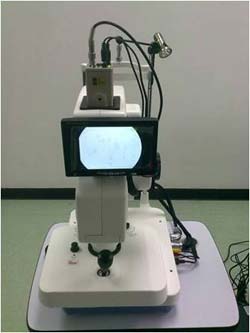Keep the precious eye in check

The retinal imaging system <br>Copyright : The Hong Kong Polytechnic University<br>
People with diabetes want to stay active and lead a healthy life free from complications such as kidney disease, heart disease and stroke. However, many patients cannot escape from the common threat of Diabetic Retinopathy, a sort of damage to the blood vessels in the retina caused by poor blood circulation, which can inflict permanent vision damage and eventually lead to blindness. Our eye seldom complains before vision damage is felt. Therefore, early detection through routine eye screening can spare the sight.
That is why researchers from PolyU's Department of Computing have recently developed a smart retinal imaging solution that makes it incredibly simple to keep the eye closely monitored. Unlike fundus cameras used in conventional eye examination, this novel instrument integrates leading-edge computing technologies into advanced cameras to provide automated detection of diabetic retinopathy. Featuring a unique retina image analyser, the system reads digital photos of the retina and check for broken blood vessels and other signs of diabetes damage within minutes. In the absence of eye doctors or specialists, it automatically makes diagnosis and spots patients who are in need of doctor referral for a full eye examination. This sort of simple operation opens up the procedure to less trained technicians. Retina photos can also be printed off and passed on to doctors.
All people with diabetes are at risk for Diabetic Retinopathy. In United States alone, about 40% of diabetes patients are being affected by diabetic retinopathy. Therefore, early detection is important because diabetic retinopathy can be reversed or stopped with a simple surgery at its onset. Sadly to say, some countries like France is lack of a national screening program which results in a steady rise in visual handicaps related to diabetes.
Accurate diagnosis relies on high quality retinal image. Our new system incorporates imaging enhancing features such as auto-focus function and well-balance illumination, thus intelligently adjusting the camera lens to eyeball of any diameters. In spite of poor patient fixations or other difficulties, it produces ultra-clear pictures that can be hardly achieved through manual control.
In addition, the automatic system can capture retinal images without dilating our pupils, allowing clinics and hospitals to perform the scanning faster. The principal investigator of this project Professor Jane You said, “This sort of quick test will allow more people to have the initial eye screening. It would be a pity seeing patients fall through the cracks and miss the chance of early and effective intervention.” The new imaging technology marks a significant advancement in eye care that will benefit millions of diabetics around the world.
Another feature of this innovation is its advanced capabilities in archive management that allows retinal images to be captured, stored and uniquely associated with a patient to produce a legitimate proof of the disease for insurance claims. Besides, data security functions are also available to forestall any unauthorized access and misuse of personal data and medical records. Patients can therefore trust their digitalized medical history with eye clinics and hospitals.
Automatic diagnosis point the way to the future of diabetic eye care. As an easier, faster and highly effective eye screening tool, this comprehensive system has just snapped a Gold Medal and a Special Prize in the 39th International Exhibition of Inventions of Geneva in April this year. Professor You added, “These awards testify our efforts in protecting patients against vision loss. In the near future, computing technologies will be the drivers of medical breakthroughs. Therefore, PolyU's Department of Computing will work towards this goal and keep on inventing more and better ways to manage other chronic diseases.”
Reference
Natacha Germain, Bodgan Galusca, Nilanjana Deb-Joardar, Luc Millot, Pierre Manoli, Gilles Thuret, Philippe Gain, and Bruno Estour, “No Loss of Chance of Diabetic Retinopathy Screening by Endocrinologists With a Digital Fundus Camera”, Diabetes Care March 2011 vol. 34 no. 3 580-585.
Gold Medal with Jury's Commendation and Special Prize at 39th International Exhibition of Inventions of Geneva
Copyright : The Hong Kong Polytechnic University
Media Contact
More Information:
http://www.polyu.edu.hkAll latest news from the category: Medical Engineering
The development of medical equipment, products and technical procedures is characterized by high research and development costs in a variety of fields related to the study of human medicine.
innovations-report provides informative and stimulating reports and articles on topics ranging from imaging processes, cell and tissue techniques, optical techniques, implants, orthopedic aids, clinical and medical office equipment, dialysis systems and x-ray/radiation monitoring devices to endoscopy, ultrasound, surgical techniques, and dental materials.
Newest articles

Silicon Carbide Innovation Alliance to drive industrial-scale semiconductor work
Known for its ability to withstand extreme environments and high voltages, silicon carbide (SiC) is a semiconducting material made up of silicon and carbon atoms arranged into crystals that is…

New SPECT/CT technique shows impressive biomarker identification
…offers increased access for prostate cancer patients. A novel SPECT/CT acquisition method can accurately detect radiopharmaceutical biodistribution in a convenient manner for prostate cancer patients, opening the door for more…

How 3D printers can give robots a soft touch
Soft skin coverings and touch sensors have emerged as a promising feature for robots that are both safer and more intuitive for human interaction, but they are expensive and difficult…





















